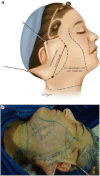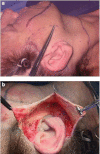The eutrophic rhytidoplasty: Subdermal tunneling and minimal skin undermining
- PMID: 23335838
- PMCID: PMC3547241
- DOI: 10.1007/s00238-012-0767-2
The eutrophic rhytidoplasty: Subdermal tunneling and minimal skin undermining
Abstract
BACKGROUND: Patients submitted to rhytidectomy usually relay their desire for briefer surgical procedures and a shorter post-operative period with faster recovery. In view of this, a technique in which the skin of the cervico-mandibular region is not undermined but only detached by blunt dissection was developed. METHODS: A retrospective study of the senior author's experience in eutrophic rhytidoplasty (EUR), the technique proposed herein, for facial rejuvenation was conducted. Patients submitted to EUR over a 10-year period were included in this study. A total of 224 interventions were performed. The procedure consists of using subdermal tunneling, performed with a cannula along the neck region and the midface area (combined or not with liposuction in certain areas, as needed), thus preserving nervous and vascular connections. The conventional skin undermining is minimal, just 4 cm around the auricular pavilion. Data were collected from the patients' medical records at Interclínica-Centroplástica Clinic in Rio de Janeiro, Brazil. RESULTS: Due to the skin eutrophic conditions, the operated patients, using the EUR technique, presented promising esthetical results. The mean rate of complications associated with the proposed technique was 1.7 %. The author found that this technique offers very promising results, a fact evidenced by the lower rate of complications among patients submitted to it. CONCLUSIONS: The EUR is a reliable option for facial rejuvenation due to the fact that it is less invasive, with a low morbidity and rate of complications. Its surgical time is reduced by 50 %, it has a shorter down-time, and yields natural results. Level of Evidence: Level IV, therapeutic study.
Figures











References
LinkOut - more resources
Full Text Sources
